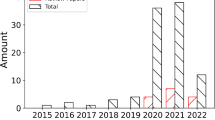Abstract
Fruits are the eminent export agriculture product for any country, especially grape, it is used for making wines and developing raisins. Moreover, Viticulture has proven to be one of the highly profitable industry from the economic point of view. However, in viticulture grape quality should be of top-notch quality, moreover throughout the research it is observed that grape quality is degraded mainly due to the plant disease. In past several researcher have tried their efforts to detect the early identification of disease. Segmentation plays bigger role identifying the disease, Hence in this paper we propose an Adaptive Snake Model for segmentation and region identification. ASA (Adaptive Snake Model) is two phase segmentation model namely common segmentation and absolute segmentation. Through common segmentation, we achieve the fast segmentation and through the absolute segmentation, we achieve the better accuracy. Moreover for evaluation of Adaptive Snake Algorithm two standard dataset i.e. PlantLevel and PlantVillage dataset, for further evaluation we have compared with various state-of-art technique in terms of various performance metric such as PSNR, Dice, Manhattan, Recall and Jaccard. Adaptive Snake Algorithm performs better than the other existing methodology.


Similar content being viewed by others
References
Beucher S, Meyer F (1993) The morphological approach to segmentation: the watershed transformation. Opt. Eng. 34:433–481 Chapter 12
Boykov YY, Jolly MP (2001) Interactive graph cuts for optimal boundary & region segmentation of objects in N-D images. In: Proc. ICCV, 2001, Vancouver, Canada, pp 105–112.
Cerutti G, Tougne L, Vacavant A, Coquin D (2011) A Parametric Active Polygon for Leaf Segmentation and Shape Estimation. In: Bebis G et al (eds) Advances in Visual Computing. ISVC 2011. Lecture notes in computer science, vol 6938. Springer, Berlin, Heidelberg
Chaudhary P, Chaudhari AK, Cheeran AN et al (2012) Color transform based approach for disease spot detection on plant leaf. Int J Comput Sci Telecommun 3(6):65–70
Comaniciu D, Meer P (2002) Mean shift: a robust approach toward feature space analysis. IEEE Trans Pattern Anal Mach Intell 24(5):603–619
Couprie C, Najman L, Grady L, Talbot H (2009) Power watersheds: a new image segmentation framework extending graph cuts, random walker and optimal spanning forest. In: Proc. ICCV, Kyoto, Japan, pp 731–738
Dornbusch T, Andrieu B (2010) Lamina2Shape—An image processing tool for an explicit description of lamina shape tested on winter wheat ( Triticum aestivum L.). Comput Electron Agric 70:217–224. https://doi.org/10.1016/j.compag.2009.10.009
Felzenszwalb PF, Huttenlocher DP (2004) Efficient graph-based image segmentation. Int J Comput Vis 59(2):167–181
Flory RE (1985) Image acquisition technology. Proceed IEEE 73(4):613–637
Gao H, Siu W-C, Hou C-H (2001) Improved techniques for automatic image segmentation. IEEE Trans Circuit Syst Video Technol 11(12):1273–1280
Goëau H, Bonnet P, Joly A, Boujemaa N, Barthelemy S, Molino JMF, Birnbaum P, Mouysset E, Picard M (2011) The ImageCLEF 2011 plant images classification task. Image CLEF2011 working Notes.
Grand-Brochier M, Vacavant A, Cerutti G, Kurtz C, Weber J, Tougne L (2015) Tree leaves extraction in natural images: comparative study of preprocessing tools and segmentation methods. IEEE Trans Image Process 24(5):1549–1560
Guo W, Rage UK, Ninomiya S (2013) Illumination invariant segmentation of vegetation for time series wheat images based on decision tree model. Comput Electron Agric 96:58–66 ISSN 0168-1699
Hanping M, Yan Cheng Z, Bo H (2008) Segmentation of crop disease leaf images using fuzzy C-means clustering algorithm. Trans CSAE 24(9):136–140
N. Jmour, S. Zayen and A. Abdelkrim (2018) "Convolutional neural networks for image classification," 2018 International Conference on Advanced Systems and Electric Technologies (IC_ASET). Hammamet. :397–402.
Kaur R, Kang SS (2015) An enhancement in classifier support vector machine to improve plant disease detection. IEEE 3rd Int Conf Innovat Technol Educ (MITE), 135–140
Khirade SD, Patil AB (2015) Plant Disease Detection Using Image Processing". 2015 Int Conf Comput Commun Control Autom, Pune. :768–771.
Krabi Qin F, Liu D, Sun B et al (2016) Identification of alfalfa leaf diseases using image recognition technology. PLoS One 11(12):1–26
Kurtz C, Passat N, Gançarski P, Puissant A (2012) Extraction of complex patterns from multiresolution remote sensing images: a hierarchical top-down methodology. Pattern Recogn 45(2):685–706
Larese M, Craviotto RM, Arango MR, Gallo C, Granitto PM (2012) Legume Identification by Leaf Vein Images Classification. 447–454. https://doi.org/10.1007/978-3-642-33275-3_55.
Li SX, Chang HX, Zhu CF (2010) Adaptive pyramid mean shift for global real-time visual tracking. Image Vis Comput 28(3):424–437
Menukaewjinda A, Kumsawat P, Attakitmongcol K (2008) Grape leaf disease detection from color imagery using hybrid intelligent system. Proceeding of ECT1-CON 14(17):513–516
Otsu N (1979) A threshold selection method from gray-level histograms. IEEE Trans Syst Man, Cybern 9(1):62–66
S. S. Patil and S. A. Thorat (2016) "Early detection of grapes diseases using machine learning and IoT," 2016 Second International Conference on Cognitive Computing and Information Processing (CCIP), Mysore. :1–5.
Shelhamer E, Long J, Darrell T (2017) Fully Convolutional Networks for Semantic Segmentation. IEEE Trans Pattern Anal Mach Intel 39(4):640–651
Sklansky J (1978) Image segmentation and feature extraction. IEEE Trans Syst, Man, Cybern 8(4):237–247
Sonka M., Hlavac V., Boyle R. (1993) Image pre-processing. In: Image Processing, Analysis and Machine Vision. Springer, Boston, MA
Tian Y, Lin Z (2012) Study on the methods of detecting cucumber downy mildew using Hyperspectral imaging technology. Physics Procedia 33:743–750 ISSN 1875-3892
Yugang R, Jian Z, Miao L et al (2012) Segmentation method for crop disease leaf images based on watershed algorithm. J Comput Appl 32(3):752–755
Author information
Authors and Affiliations
Corresponding author
Additional information
Publisher’s note
Springer Nature remains neutral with regard to jurisdictional claims in published maps and institutional affiliations.
Rights and permissions
About this article
Cite this article
Shantkumari, M., Uma, S.V. Grape leaf segmentation for disease identification through adaptive Snake algorithm model. Multimed Tools Appl 80, 8861–8879 (2021). https://doi.org/10.1007/s11042-020-09853-y
Received:
Revised:
Accepted:
Published:
Issue Date:
DOI: https://doi.org/10.1007/s11042-020-09853-y




